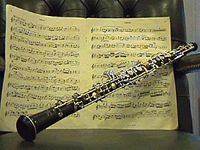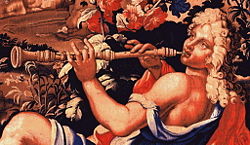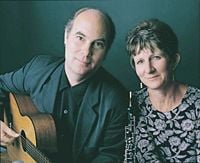Oboe
 From Nwe
From Nwe  |
||||||
|
The oboe is a double reed musical instrument of the woodwind family. The English word "oboe" is a corruption of the French word for oboe, hautbois, which is a compound word made of haut meaning "high" and bois, meaning "wood." A musician who plays the oboe is called an oboist. Careful manipulation of embouchure and air pressure allows the player to express a large timbral and dynamic range. Along with the French horn, the oboe is often considered one of the most difficult instruments to master.
Because the oboe's penetrating sound and expressive abilities, it has been an important instrument for composers from the time of its invention.
The instrument

Voice
In comparison to other modern woodwind instruments, the oboe has a clear and penetrating voice. The timbre of the oboe is derived from the oboe's conical bore (as opposed to the generally cylindrical bore of flutes and clarinets). As a result, oboes are readily audible over other instruments in large ensembles. Its tone quality makes it highly suitable to musical expressions that are melancholic, plaintive, and somber.
Modern symphony orchestras adjust their collective tuning by listening to an oboist play a concert A (A440). Some European orchestras tune to a slightly higher pitch (A442-A445). Adjusting the pitch of the oboe is achieved by permanently altering the "scrape," removing cane from the reed, or changing the position of the reed in the instrument. The latter method is considered a last resort, because adjusting the position of the reed may cause some notes to warble. Subtle changes in pitch are also possible by adjusting the embouchure. The oboe is pitched in concert C and has a mezzo-soprano (mid-high) to soprano (high) range.
Baroque oboe
The Baroque oboe first appeared in French courts under Jean-Baptiste Lully in the late seventeenth century, where it was known as the hautbois.

The basic form of the instrument was derived from the shawm, an instrument widely used in the Medieval and Renaissance periods. Musician and instrument maker Martin Hotteterre (d. 1712) was responsible for many of the new instrument's early developments. The instrument quickly spread throughout Europe, including England, where it was called "hautboy" or "hoboy." It was the main melody instrument in early military bands, until it was succeeded by the clarinet.
The Baroque oboe was generally made from boxwood and had three keys; a "great," and two side keys. The side key was often doubled to facilitate use of either the right or left hand on the bottom holes. In order to produce higher pitches, the player had to "overblow," or increase the air stream to reach the next harmonic. Notable oboe makers of the period were Denner and Eichentopf in Germany, and the the father-and-son makers Stanesby Sr. and Jr., in England. The range for the Baroque oboe comfortably extends from C4 to D6. With the resurgence of interest in early music in the mid-twentieth century, a few makers began producing copies to specifications from surviving historical instruments.
The Classical oboe

The Classical period brought an oboe whose bore was gradually narrowed, and the instrument became outfitted with several keys, among them were those for the notes D-sharp, F, and G-sharp. A key similar to the modern octave key was also added, called the "slur key," though it was at first used more like the "flick" keys on the modern German bassoon. Only later did French instrument makers redesign the octave key to be held open for the upper register, closed for the lower. The narrower bore allowed the higher notes to be more easily played, and composers began to more often utilize the oboe's upper register in their works. Because of this, the oboe's tessitura in the Classical era was somewhat broader than that found in Baroque works.
The range for the Classical oboe extends from C4 to F6 (according to piano note frequencies), though some German and Austrian oboes were capable of playing one half-step lower (B4). Classical-era composers who wrote concertos for oboe include Mozart, Haydn, Beethoven, and numerous others. Innumerable solos exist for the oboe in chamber, symphonic, and operatic compositions from the Classical era.
The Viennese oboe
In Vienna, a unique oboe has been preserved with its bore and tonal characteristics remaining relatively unchanged in use to the present day. The Akademiemodel oboe, developed in the early twentieth century by Hermann Zuleger, is now made by a select few makers, notably Guntram Wolf and Yamaha. Apart from its use in the major Viennese orchestras, which continue to exploit the Akademiemodel's unique musical color, it is not used.
The modern oboe
The oboe was developed further in the nineteenth century by the Triebert family of Paris. Using the Boehm flute as a source of ideas for key work, Guillaume Triebert and his sons, Charles and Frederic, devised a series of increasingly complex yet functional key systems. F. Lorée of Paris made further developments to the modern instrument. Minor improvements to the bore and key work have continued through the twentieth century, but there has been no fundamental change to the general characteristics of the instrument for several decades.

The modern oboe is most commonly made from grenadilla wood (African blackwood), though some manufacturers also make oboes out of other members of the dalbergia family of woods, which includes cocobolo, rosewood, ebony, and violetwood. Student model oboes are often made from plastic resin, to avoid instrument cracking that wood instruments are prone to, but also to make the instrument more economical. The oboe has an extremely narrow conical bore. The oboe is played with a double reed consisting of two thin blades of cane tied together on a small-diameter metal tube (staple), which is inserted into the reed socket at the top of the instrument. The commonly accepted range for the oboe extends from B-flat 4 to about G3, over two and a half octaves, though its common range lies from C4 to E-flat 6. Some student oboes only extend to B4; the key for B-flat is not present, however this variant is becoming less common.
A modern oboe with the "full conservatory" ("conservatoire" outside the U.S.) or Gillet key system has 45 pieces of keywork, with the possible additions of a third octave key and alternate (left little finger) F or C-key. The keys are usually made of nickel silver, and are silver or occasionally gold-plated. Besides the full conservatoire system, oboes are also made using the English thumbplate system. Most have "semi-automatic" octave keys, in which the second octave action closes the first, and some have a fully automatic octave key system, as used on saxophones. Some full conservatory oboes have finger holes covered with rings rather than plates ("open-holed"), and most of the professional models have at least the right hand third key open-holed. Professional oboes used in the UK frequently feature conservatoire system combined with a thumb plate. With this type of mechanism the oboist has the best of both worlds as far as the convenience of fingerings is concerned.
Other members of the oboe family
The oboe has several siblings. The most widely known today is the Cor anglais, or English horn, the tenor (or alto) member of the family. A transposing instrument, it is pitched in F which is a perfect fifth lower than the oboe. The oboe d'amore, the alto (or mezzo-soprano) member of the family, is pitched in A, a minor third lower than the oboe. J.S. Bach made extensive use of both the oboe d'amore as well as the taille and oboe da caccia, Baroque antecedents of the cor anglais. Even less common is the bass oboe (also called baritone oboe), which sounds one octave lower than the oboe. Delius and Holst both scored for the instrument. Similar to the bass oboe is the more powerful heckelphone, which has a wider bore and larger tone than the bass oboe. Only 165 heckelphones have ever been made, and competent players are hard to find. The least common of all are the musette (also called oboe musette or piccolo oboe), the sopranino member of the family (it is usually pitched in E-flat or F above the oboe), and the contrabass oboe (typically pitched in C, two octaves deeper than the standard oboe).
Keyless folk versions of the oboe (most descended from the shawm) are found throughout Europe. These include the musette (France) and bombarde (Brittany), the piffaro and ciaramella (Italy), and the xirimia or chirimia (Spain). Many of these are played in tandem with local forms of bagpipe. Similar oboe-like instruments, most believed to derive from Middle Eastern models, are also found throughout Asia as well as in North Africa.
Classical works featuring the oboe
- Wolfgang Amadeus Mozart, Oboe Concerto in C major, Quartet in F major
- Antonio Vivaldi, Oboe Concerti
- Johann Sebastian Bach, Brandenburg Concertos nos. 1 and 2, Concerto for Violin and oboe, lost oboe concerti, numerous oboe obbligato lines in the sacred and secular cantatas
- Tomaso Albinoni, Oboe (and two oboe) Concerti
- George Frideric Handel, The Arrival of the Queen of Sheba, Oboe Concerti and Sonatas
- Georg Philipp Telemann, Oboe Concerti and Sonatas, trio sonatas for oboe, recorder and basso continuo
- Richard Strauss, Oboe Concerto
- Joseph Haydn (spurious), Oboe Concerto in C major
- Vincenzo Bellini, Concerto in E major (arranged)
- Luciano Berio, Sequenza VII
- Domenico Cimarosa, Oboe Concerto in C major (arranged)
- Francis Poulenc, Oboe Sonata
- Benjamin Britten, Six Metamorphoses after Ovid, Temporal Variations
- Robert Schumann, Three Romances for Oboe or Violin
- Edmund Rubbra, Oboe Sonata
- Alex Klein, Richard Strauss' Oboe Concerto (with Daniel Barenboim and the Chicago Symphony).
- Carl Nielsen, Two Fantasy Pieces for Oboe and Piano
- Alessandro Marcello, Concerto in D/C minor
- Ralph Vaughan Williams, Concerto for Oboe and Strings, Ten Blake Songs for oboe and tenor
- Camille Saint-Saëns, Sonate for Oboe and Piano in D Major and Bacchanale from Samson and Delilah
- Peter IlyichTchaikovsky, Symphony No. 4 in F Minor (2nd Movement)
- Bohuslav Martinu, Oboe Concerto
- John Barnes Chance, Variations on a Korean Folk Song
- Witold Lutoslawski, Double Concerto for Oboe and Harp
- Ellen Taaffe Zwilich, Oboe Concerto
- Paul Hindemith, Sonate for Oboe and Piano
- Ennio Morricone, Gabriel's Oboe from The Mission. It is usually followed by the Mission's main theme and the choral symphony On Earth as it is in Heaven.
- Igor Stravinsky, Pastorale (transcribed in 1933, for Violin and Wind Quartet)
Classical works featuring English horn
- Ottorino Respighi, Pini di Roma (4th Movement)
- Aaron Copland, Quite City
- Jean Sibelius, The Swan of Tuonela
- Nikolai Rimsky-Korsakov, Capriccio Espagnol and Scheherezade, Op. 35
- Hector Berlioz,Roman Carnival Overture and Symphonie Fantastique
- Gioacchino Rossini, William Tell Overture
- Claude Debussy, Nocturnes
- Antonin Dvorak, Symphony No. 9 (2nd Movement)
- Peter Ilyich Tchaikovsky, Romeo and Juliet Fantasy Overture
- Cesar Franck, Symphony in D minor
- Alexander Borodin, In the Steppes of Central Asia
- Sergei Rachmaninoff, Symphonic Dances, Op. 45
- Maurice Ravel, Piano Concerto in G
- Igor Stravinsky, The Rite of Spring
The oboe outside of classical music
While the oboe is rarely used in musical genres other than Western classical, there have been a few notable exceptions.
Traditional and folk music
Although keyless folk oboes are still used in many European folk music traditions, the modern oboe has been little used in folk music. One exception was the late Derek Bell, harpist for the Irish group The Chieftains, who used the instrument in some performances and recordings. The U.S. contra dance band Wild Asparagus, based in western Massachusetts, also uses the oboe, played by David Cantieni.
Jazz

Although the oboe has never been featured prominently in jazz music, some early bands, most notably that of Paul Whiteman, included it for coloristic purposes. The multi-instrumentalist Garvin Bushell (1902-1991) played the oboe in jazz bands as early as 1924, and used the instrument throughout his career, eventually recording with John Coltrane in 1961. Gil Evans scored for the instrument in his famous Miles Davis collaboration Sketches of Spain. Though primarily a tenor saxophone and flute player, Yusef Lateef was among the first (in 1963) to use the oboe as a solo instrument in modern jazz performances and recordings. The 1980s saw an increasing number of oboists try their hand at non-classical work, and many players of note have recorded and performed alternative music on oboe. Oboist Nancy Rumbel and her husband, guitarist Eric Tingstand, received the 2002 Grammy Award for Best New Age Album for their album Acoustic Garden.
Rock
The oboe has been used sporadically in rock recordings, generally by studio musicians on recordings of specific songs such as "Hergest Ridge" by Mike Oldfield, although a few bands have featured oboists as members. Such bands include Henry Cow, Roxy Music, China Crisis, and Sigur Rós. The oboists in these bands generally used the oboe as a secondary instrument, not playing it on every song. British composer-performer and multi-instrumentalist Roy Wood used the oboe in some of the later works of The Move (for example, "It Wasn't My Idea To Dance"), during his short tenure with the Electric Light Orchestra, and in his other work, including with Wizzard. Indie rock musician Sufjan Stevens plays the oboe and cor anglais, and often overdubs both instruments on his albums.
The American rock band REM features the oboe in several tracks of their 1991 album Out of Time, most notably as the lead melodic instrument on the wordless song "Endgame," as well as on four tracks of their 1992 album Automatic for the People. The oboe is also featured in the Stereophonics' 2001 cover of "Handbags and Gladrags" by Rod Stewart. Jarlaath, the vocalist of the French gothic metal band Penumbra, plays the oboe in a number of their songs, as does Robbie J. de Klerk, the vocalist of the Dutch melodic doom/death metal band, Another Messiah. Queen's song "It's A Beautiful Day," which appears on the group's 1995 album Made in Heaven, contains an oboe part conceived by bassist John Deacon. Portastatic's recordings also feature oboe.
Film music
The oboe is frequently featured in film music, often to underscore a particularly poignant or sad scene. One of the most prominent uses of the oboe in a film score is Ennio Morricone's "Gabriel's Oboe" theme from The Mission.
It is also featured as a solo instrument in the theme "Across the Stars" from the John Williams score to Star Wars Episode II: Attack of the Clones.
References
ISBN links support NWE through referral fees
- Burgess, Geoffrey, and Bruce Haynes. The Oboe. New Haven: Yale University Press, 2004. ISBN 0-300-09317-9.
- Goossens, Leon, and Edwin Roxburgh. Oboe. London: Kahn & Averill, 1993. ISBN 1-871-08243-9.
- Van Cleve, Libby. Oboe Unbound: Contemporary Techniques. Lanham, MD: Scarecrow Press, 2004. ISBN 0-810-85031-1.
External links
All links retrieved November 17, 2022.
- ASU Oboe Homepage www.public.asu.edu
- Oboe fingering guide www.wfg.woodwind.org
- Oboist Liang Wang: His Reeds Come First NPR story by Debbie Elliott www.npr.org
- Oboe insight www.oboeinsight.com
Credits
New World Encyclopedia writers and editors rewrote and completed the Wikipedia article in accordance with New World Encyclopedia standards. This article abides by terms of the Creative Commons CC-by-sa 3.0 License (CC-by-sa), which may be used and disseminated with proper attribution. Credit is due under the terms of this license that can reference both the New World Encyclopedia contributors and the selfless volunteer contributors of the Wikimedia Foundation. To cite this article click here for a list of acceptable citing formats.The history of earlier contributions by wikipedians is accessible to researchers here:
- Oboe history
The history of this article since it was imported to New World Encyclopedia:
- History of "Oboe"
Note: Some restrictions may apply to use of individual images which are separately licensed.
↧ Download as ZWI file | Last modified: 02/04/2023 00:29:49 | 49 views
☰ Source: https://www.newworldencyclopedia.org/entry/Oboe | License: CC BY-SA 3.0
 ZWI signed:
ZWI signed:

 KSF
KSF